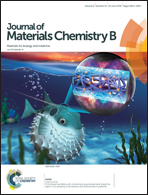Biologically inspired, catechol-coordinated, hierarchical organization of raspberry-like calcium phosphate nanospheres with high specific surface area†
Abstract
The elaborate design of calcium phosphates (CaP) with a hierarchical structure for biomedical applications is severely restricted due to their instinctive pertinacious irregular agglomeration. Thus, the development of mesoporous CaP with large internal pores is far from satisfactory. In this study, catechol is selected as a modifier to intervene in the precipitation of CaP. Compared to pure CaP with smooth irregular aggregates with an average size of 110 nm, the catechol-intervened CaP (CaP/Cat) samples are raspberry-like nano-spherical assemblies of ca. 25 nm nanoparticles. The obtained spheres possess a mesoporous structure, large interior pores and high specific surface area, which endow them with a high protein adsorption capacity and high DNA delivery efficacy. Catechol is subjected to oxidative polymerization while CaP precipitation occurs. This simultaneous reaction is supposed to play a crucial role in directing the assembling of the CaP/Cat nanospheres. The flexible catechol moiety is shown to be a novel and promising modifier for manufacturing CaP with tunable structures and properties for various applications.



 Please wait while we load your content...
Please wait while we load your content...